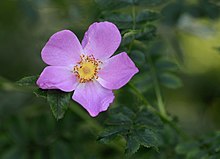Rosa virginiana
Rosa virginiana, commonly known as the Virginia rose,[2] common wild rose or prairie rose, is a woody perennial in the rose family native to eastern North America, where it is the most common wild rose.[3] It is deciduous, forming a suckering shrub up to 2 metres in height, though often less. The stems are covered in numerous hooked prickles. The leaves are pinnate, usually with between 7 and 9 glossy leaflets. The pink flowers are borne singly or in small clusters and appear over a long period in midsummer. The fruits are small, round and bright red, rich in vitamin C and edible, being both used to make jams and tea.[4]
| Virginia rose | |
|---|---|
 | |
| Scientific classification | |
| Kingdom: | Plantae |
| Clade: | Tracheophytes |
| Clade: | Angiosperms |
| Clade: | Eudicots |
| Clade: | Rosids |
| Order: | Rosales |
| Family: | Rosaceae |
| Genus: | Rosa |
| Species: | R. virginiana |
| Binomial name | |
| Rosa virginiana | |
Quest-Ritson and Quest-Ritson describe R. virginiana as "the best all-rounder among the wild roses", and draw attention to its leaf coloration in the fall: "the whole plant turns yellow, orange, scarlet, crimson and brown for weeks on end".[5]
In cultivation, this plant has gained the Royal Horticultural Society's Award of Garden Merit.[6]
References
- NatureServe (2006), "Rosa virginiana", NatureServe Explorer: An online encyclopedia of life, Version 6.1., Arlington, Virginia
- Rosa virginiana at USDA PLANTS Database
- Phillips, R. and Rix, M. The Ultimate Guide to Roses, Macmillan, 2004, p25
- Niering, William A.; Olmstead, Nancy C. (1985) [1979]. The Audubon Society Field Guide to North American Wildflowers, Eastern Region. Knopf. p. 758. ISBN 0-394-50432-1.
- Quest-Ritson, C. and Quest-Ritson, B., The Royal Horticultural Society Encyclopedia of Roses, Dorling Kindersley, 2003, p413
- "Rosa virginiana". Royal Horticultural Society. 2017. Retrieved 2017-01-15.
